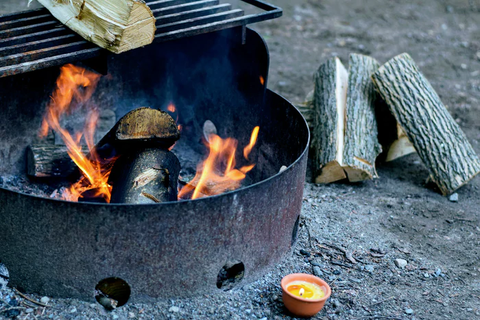
Autumn is upon us. Fall time brings an assortment of apples, pumpkins, and corn mazes to get lost in or found in. Autumn is the time I savor the richness of one of my favorite teas...Lapsang Souchong.
History

Legend states that Lapsang Souchong was created by happenstance in the late Ming Dynasty (1368 - 1644). Numerous soldiers made camp in tea factories throughout Fujian Province, China. By the time tea garden workers resumed processing of the tea, it was too late to dry the tea leaves in the accustomed manner. The workers needed to dry the leaves quickly and thus, lit pine fires to hasten the drying of the tea. The tea was then sent to market where it was a resounding success and demand has been consistently solid for this smoky tea.
The most sought after Lapsang Souchong teas are produced in the Wuyi Shan mountain region in Fujian Province. La in the Fuzhou dialect means “pine” and Sang is translated as “wood”. Souchong is defined as a quality leaf from the Wuyi mountains tea bush. It is this tea that is purported to have been a favorite tea of Winston Churchill.
Processing

The tea derives its smokiness during two stages of the tea production. The first layer of smokiness is obtained when the leaves are withered in a room above a smoke filled chamber for approximately two hours. Afterwards, the tea is rolled and shaped into spindly needle like leaves. The leaves are then left to oxidize. When oxidation is complete the leaves are dried slowly and carefully above a smoke filled room. The leaves absorb additional smoke as they dry.
Flavor Profile

Lapsang Souchong has a unique flavor profile. It is the only black tea with an intentional smoky aroma and flavor. Other teas may have an accidental smokiness due to faulty firing, baking, or drying of the tea leaves. Lapsang Souchong, on the other hand, is withered and dried above pine fires, creating a wonderful smoky pine taste.
The dry Lapsang Souchong leaf has a pine, mineral, and slightly sweet aroma with a hint of raisins or a stone fruit. It reminds me of sitting around a campfire, and roasting marshmallows. The aroma of the dry leaf also reminds me of an old library that has a roaring fire in a fireplace. A place where looking at old books is met with the coziness of an aromatic, warm and crackling fire in the fireplace.
The wet leaves of the Lapsang Souchong tea is reminiscent of cigar smoke. It has a pine, smoky, and slightly sweet aroma to the wet leaf. The sweetness in the aroma of the tea leaves lingers and blends with the smokiness from a pine fire.
The liquor has a wonderful smoky aroma that reminds me of beach bonfires, camping in the woods, or enjoying a fire at a ski lodge after a day of skiing, snowmobiling, or snowshoeing. The tea has a full body, a medium mouthfeel and a sweet finish to the flavor profile. The flavor of the tea encapsulates a forest element with a wet pine wood flavor. Lapsang Souchong has a juxtaposition of flavors all in one cup. It has a smoky, pine and slightly mineral flavor and yet, a smooth sweet finish with a hint of stone fruit (for example, apricots). A truly remarkable Lapsang Souchong should not be so overpoweringly smoky in flavor that it becomes ashy or gritty in mouth feel and taste.
Alternative Usage
Lapsang Souchong is a versatile tea. It can be consumed as a beverage, or used in recipes. The tea liquor can be added to barbecue sauce, chili, or stew. It pairs well with poultry, beef, or pork. The dry leaves can be used in a meat rub prior to smoking meat on a grill. The dry leaves, when used to coat the outside of a block of cheese, add visual interest and a unique flavor to the charcuterie board. Lastly, the dry leaves could be left in a bowl in a room to act as potpourri, infusing the room with a comforting campfire scent.
There are plenty of uses for Lapsang Souchong in addition to steeping and consuming it as a beverage. Have fun creatively incorporating the tea into the kitchen, hearth, and home.
Leslie
About The Author
 Leslie Sundberg is a World Tea Academy Certified Tea Specialist, a World Tea Academy Apprentice Tea Sommelier, a Specialty Tea Institute Level IV trained Tea Specialist, and a Tea and Business Etiquette Specialist. On any given day, Leslie can be found teaching, speaking or sharing in the joys of a cup of tea. No matter what Leslie is doing or where she is, one thing remains constant: 4:00 in the afternoon is tea time!
Leslie Sundberg is a World Tea Academy Certified Tea Specialist, a World Tea Academy Apprentice Tea Sommelier, a Specialty Tea Institute Level IV trained Tea Specialist, and a Tea and Business Etiquette Specialist. On any given day, Leslie can be found teaching, speaking or sharing in the joys of a cup of tea. No matter what Leslie is doing or where she is, one thing remains constant: 4:00 in the afternoon is tea time!
